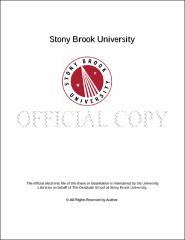| dc.identifier.uri | http://hdl.handle.net/11401/76856 | |
| dc.description.sponsorship | This work is sponsored by the Stony Brook University Graduate School in compliance with the requirements for completion of degree. | en_US |
| dc.format | Monograph | |
| dc.format.medium | Electronic Resource | en_US |
| dc.language.iso | en_US | |
| dc.publisher | The Graduate School, Stony Brook University: Stony Brook, NY. | |
| dc.type | Dissertation | |
| dcterms.abstract | A model’s validity, or its goodness-of-fit to the real world system, is commonly assessed by quantifying the level of agreement between the observed data and their corresponding model-simulated outputs. However, the observed data could be uncertain given inaccuracies in the observational tools and techniques while the model-simulated outputs may be incomparable since models are simplified versions, and not exact replicas, of the real world system. This limits the abilities of the traditional validation approaches. Here, an alternative approach called the area metric (Ferson et al. 2008) was adopted for multi-model validation assessment. This approach quantifies the level of agreement between the observed data and the model-simulated outputs expressed as their respective empirical cumulative distribution functions. The area metric approach was used to assess the validity of multiple model variants of a base model that simulates the groundwater conditions in the vicinity of the municipal landfill in the Town of Brookhaven, NY. Uncertainties regarding the configuration and the characteristics of a groundwater system were represented by developing 288 model variants of varying conceptualizations of the base model. These models’ validity was assessed over a conservative range of groundwater head data from 133 observation wells. Based on the calculated model area metric values, the models were ranked and the 10 models with the lowest area metric values were selected as conforming best to the data. In this way, the area metric-based multi-model assessment selects, from a model space, better representations of groundwater flow systems. It avoids overfitting a single model to a particular system state and facilitates incorporation of the epistemic and aleatory uncertainties into the validation process. In addition, the approach acknowledges that finding an exact correspondence between observed data and simulated output is difficult, given all aspects of model uncertainty. Therefore, the area metric-based multi-model validation approach explicitly represented model uncertainty using multiple model variants and the degree these models replicated real conditions was tested over a range of observed data. | |
| dcterms.abstract | A model’s validity, or its goodness-of-fit to the real world system, is commonly assessed by quantifying the level of agreement between the observed data and their corresponding model-simulated outputs. However, the observed data could be uncertain given inaccuracies in the observational tools and techniques while the model-simulated outputs may be incomparable since models are simplified versions, and not exact replicas, of the real world system. This limits the abilities of the traditional validation approaches. Here, an alternative approach called the area metric (Ferson et al. 2008) was adopted for multi-model validation assessment. This approach quantifies the level of agreement between the observed data and the model-simulated outputs expressed as their respective empirical cumulative distribution functions. The area metric approach was used to assess the validity of multiple model variants of a base model that simulates the groundwater conditions in the vicinity of the municipal landfill in the Town of Brookhaven, NY. Uncertainties regarding the configuration and the characteristics of a groundwater system were represented by developing 288 model variants of varying conceptualizations of the base model. These models’ validity was assessed over a conservative range of groundwater head data from 133 observation wells. Based on the calculated model area metric values, the models were ranked and the 10 models with the lowest area metric values were selected as conforming best to the data. In this way, the area metric-based multi-model assessment selects, from a model space, better representations of groundwater flow systems. It avoids overfitting a single model to a particular system state and facilitates incorporation of the epistemic and aleatory uncertainties into the validation process. In addition, the approach acknowledges that finding an exact correspondence between observed data and simulated output is difficult, given all aspects of model uncertainty. Therefore, the area metric-based multi-model validation approach explicitly represented model uncertainty using multiple model variants and the degree these models replicated real conditions was tested over a range of observed data. | |
| dcterms.available | 2017-09-20T16:51:19Z | |
| dcterms.contributor | Tonjes, David J | en_US |
| dcterms.contributor | Ferguson, David | en_US |
| dcterms.contributor | Ferson, Scott | en_US |
| dcterms.contributor | Bokuniewicz, Henry | en_US |
| dcterms.contributor | Lewiza, Kamazima. | en_US |
| dcterms.creator | Aphale, Omkar | |
| dcterms.dateAccepted | 2017-09-20T16:51:19Z | |
| dcterms.dateSubmitted | 2017-09-20T16:51:19Z | |
| dcterms.description | Department of Technology, Policy, and Innovation. | en_US |
| dcterms.extent | 232 pg. | en_US |
| dcterms.format | Application/PDF | en_US |
| dcterms.format | Monograph | |
| dcterms.identifier | http://hdl.handle.net/11401/76856 | |
| dcterms.issued | 2015-12-01 | |
| dcterms.language | en_US | |
| dcterms.provenance | Made available in DSpace on 2017-09-20T16:51:19Z (GMT). No. of bitstreams: 1
Aphale_grad.sunysb_0771E_12641.pdf: 11859050 bytes, checksum: 9a13c5fecd7cc8ded2485140da6633ef (MD5)
Previous issue date: 1 | en |
| dcterms.publisher | The Graduate School, Stony Brook University: Stony Brook, NY. | |
| dcterms.subject | Hydrologic sciences | |
| dcterms.subject | area metric, epistemic and aleatory, groundwater, multi-model, uncertainty, validation | |
| dcterms.title | Multi-Model Validation Assessment of Groundwater Flow Simulation Models Using Area Metric Approach | |
| dcterms.type | Dissertation | |

